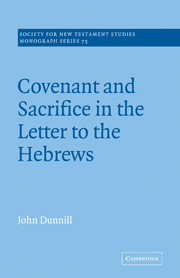Book contents
- Frontmatter
- Contents
- Preface
- List of abbreviations
- A NOTE ON TRANSLATIONS
- Introduction: Hebrews and historical criticism
- Part I Sociology
- Part II Structuralism
- Part III Renewing the covenant
- 4 A liturgy for the Day of Salvation
- 5 The narratives of the covenant
- 6 The testing of the Son of God
- 7 The necessity of blood
- 8 Worship in the new covenant
- Conclusion
- Bibliography
- Index of passages quoted
- Index of modern authors
- Subject index
8 - Worship in the new covenant
Published online by Cambridge University Press: 07 January 2010
- Frontmatter
- Contents
- Preface
- List of abbreviations
- A NOTE ON TRANSLATIONS
- Introduction: Hebrews and historical criticism
- Part I Sociology
- Part II Structuralism
- Part III Renewing the covenant
- 4 A liturgy for the Day of Salvation
- 5 The narratives of the covenant
- 6 The testing of the Son of God
- 7 The necessity of blood
- 8 Worship in the new covenant
- Conclusion
- Bibliography
- Index of passages quoted
- Index of modern authors
- Subject index
Summary
The argument running through this book has been that the cultic elements in Hebrews are if anything more extensive and more integral to the work than is usually claimed, but that their type and meaning have been misunderstood when viewed selectively in the light of an expiatory ideology. As in early Judaism, the main impulse appears to be towards systematising, synthesising the sacral types so that each composite symbol or rite expresses the whole of the sacral system; and Hebrews continues also the tendency to move away from the expiatory centre which characterises Leviticus and towards an inclusive covenant-symbolism. This means that in the typology set out in chapter 3 (figure 3), type I, personal-conjunctive, becomes the organising centre on which the rest, and especially its opposite, type IV, impersonal-disjunctive, are united. The expiatory is still of course present in Hebrews, with the sense that there remains an appropriate fear of God, but in a subordinate place corresponding to the book's argument that it has been wholly subsumed under Christ's once-for-all sacrifice. It is necessary now to examine the positive presentation of a personal-conjunctive perspective, and to show that this is a fully sacral understanding of God and his working, a different form of sacrality and not a non-sacral alternative.
Communion with God
The New Testament as a whole proclaims the message that humanity and God have now entered into a new relationship through Jesus.
- Type
- Chapter
- Information
- Covenant and Sacrifice in the Letter to the Hebrews , pp. 239 - 260Publisher: Cambridge University PressPrint publication year: 1993

